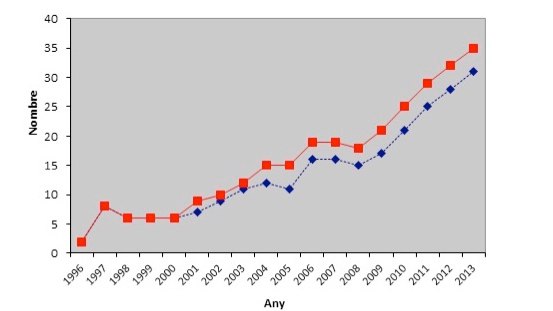Distribution and demography
Data from the PirosLife website and paysdelours.com
In 2015, 29 brown bear specimens were identified in the Pyrenees. These had different origins and were distributed over two nuclei:
- The western nucleus, which is located in the south of the French department of Pyrénées-Atlantiques, the northeast of Navarre and the northwest of Huesca. There are just two male specimens: Néré and his son Cannellito. Néré was born in 1997 and relocated from the central nucleus to the western nucleus in 2000. Cannellito was born in 2004 to Néré and the indigenous female Caramelles. The mother was later killed by a French hunter. Cannellito is therefore the only current descendant of the Pyrenean lineage, albeit only on one side.
- The central nucleus, which is made up of bears from Slovenia that were introduced into the Pyrenees in 1996, 1997 and 2006. It is located in the south of the French departments of Haute-Garonne and Ariège, the northeast of Huesca and the Catalan counties of Val d’Aran and Pallars Sobirà and, to a lesser extent, the counties of Pallars Jussà, Alta Ribagorça and Alt Urgell. A male named Goiat was released in 2016.
From the data obtained and the methodology types used (hair traps, automatic photo and video systems, observations, damage and depredation, signs and tracks, etc.), it is difficult to know the current bear population of the Pyrenees, although an estimate can be made.
Using the data obtained from genetic analysis, automatic photo and video systems and visual observations, the specimens identified in 2015 were as follows:
- Seven adult males: Pyros, Moonboots, Bonabé, Cannellito, Néré, Pélut and Pépite.
- Ten adult females: Sarousse, Caramellita, Caramelles, Hvala, Bambou, Boavi, Callista, Fadeta, Isil and Plume.
- Six subadults: Chataigne, Gaïa, S26Slo1, Boet, Esmolet and S25Slo1
- Six cubs born in 2015: S27Slo1, S26Slo2 and four undetermined.
Recent Reproduction
Five cases of reproduction were identified in 2014. Fadeta gave birth to a female cub (Auberta), the offspring of Pyros. Bambou gave birth to a male cub (S25Slo1), the offspring of Moonboots. Nheu gave birth to a male cub (S26Slo1 = Réglisse), the offspring of Moonboots. Boavi gave birth to two male cubs. Caramelles gave birth to two male cubs (Boet and Smolet).
Three litters were identified in 2015. One of these was born to Caramellita and consisted of three cubs, one of which was a male fathered by Pélut; the sex and paternity of the other two have not yet been determined. Plume gave birth to a male cub fathered by Balou. The final litter was born to Hvala and consisted of two male cubs fathered by Pyros.
The good news is that Balou reproduced with Plume before he died after being struck by lightning in 2014. The male cub could offer fresh hope for the future of the population of the central nucleus. Along with Goiat, the bear released in June 2016, he could bring new blood to the Pyrenean bear population. The paternity of three-and-a-half-year old Pépite was also a pleasant surprise, since males do not usually reproduce until they are at least five years old.
Five litters, consisting of 10 cubs, were identified in 2016, a record for the Pyrenees in the last 20 years. Genetic analysis of the samples will provide information to establish which females and which males are the parents.

